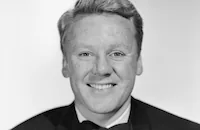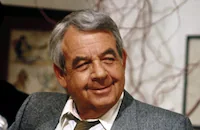Divorce American Style

Brief Synopsis
Cast & Crew
Bud Yorkin
Dick Van Dyke
Debbie Reynolds
Jason Robards Jr.
Jean Simmons
Van Johnson
Film Details
Technical Specs

Synopsis
After 16 years of marriage, Barbara and Richard Harmon have a luxurious Los Angeles home, an expensive car, and two well-behaved but somewhat precocious sons. Despite the material success of their marriage, Barbara feels that they don't communicate and she seeks out a marriage counselor. This action, coupled with the "advice" of mutual friends, soon leads to bitter arguments that land the Harmons in a divorce court, where an embittered judge grants Barbara virtually everything, leaving Richard with $87.50 a week out of a yearly gross of $25,000. While spending a Sunday with his two boys, Richard meets Nelson Downes, a divorcé frantically trying to eliminate his own alimony payments by finding a new husband for his ex-wife, Nancy. Nelson discusses the situation with Nancy, who likes Richard, and it is agreed that if the arrangement is to be financially feasible Barbara must also have a new mate. The ideal candidate is found in bachelor Big Al Yearling, a successful used car dealer. When Barbara responds to Big Al's courtship, all the combatants (including Nelson's pregnant fiancée, Eunice) meet at a nightclub on the evening before the Harmon divorce is to be made final. During a performance by hypnotist Pat Collins, Barbara permits herself to be mesmerized. After doing an uninhibited striptease on stage, she is ordered by the hypnotist to go into the audience and kiss the man she truly loves. When she plants a resounding smack on the delighted Richard, the Harmon divorce is forgotten. As Barbara and Richard return home to resume their bickering, Nelson, never one to give up easily, desperately tries to interest Nancy in Big Al.

Director

Bud Yorkin
Cast

Dick Van Dyke

Debbie Reynolds

Jason Robards Jr.

Jean Simmons

Van Johnson
Joe Flynn
Shelley Berman

Martin Gabel

Lee Grant
Pat Collins

Tom Bosley
Emmaline Henry
Dick Gautier
Tim Matthieson
Gary Goetzman
Eileen Brennan
Shelley Morrison
Bella Bruck
John J. Anthony
Crew
Dave Grusin
Sydney Guilaroff
Conrad Hall
Jack Haynes
Robert Kaufman
Ben Lane
Frances Lear
Norman Lear
Norman Lear
Bob Mackie
Rusty Meek
Howard Pine
William Randall Jr.
Charles J. Rice
Edward Stephenson
Frank [a.] Tuttle
Ferris Webster

Videos
Movie Clip





Hosted Intro
Film Details
Technical Specs

Award Nominations
Best Writing, Screenplay
Articles
Divorce American Style
Van Dyke plays Richard Harmon, a suburban husband who, after 15 years of marriage, is finally fed up with his wife, Barbara (Reynolds). Richard's unhappiness is just fine with Barbara, since she also can't stand him. So, after a futile attempt at counseling, they decide to divorce. But that's easier said than done. Richard eventually ends up befriending Nelson (Jason Robards), an alimony-strapped divorcee who wants nothing more than for Richard to marry his ex-wife (Jean Simmons), which would relieve him of all those monthly payments. It all gets very complicated, and Lear, who was nominated for an Oscar® for his screenplay, obviously enjoys putting his characters through a satirical wringer.
Bosley Crowther, the critic from the New York Times, took issue with Divorce American Style, writing that it was "rather depressing, saddening and annoying, largely because it does labor to turn a solemn subject into a great big American-boob joke." But a young Chicago critic named Roger Ebert seemed to enjoy the picture for that very reason, when he called it, "a sly, sympathetic examination of divorce in the subculture of upper middle class suburbanites - why it is funny and why, in the end, it is not funny at all."
Lear, of course, went on to mastermind the groundbreaking TV series All in the Family, and Divorce American Style has the same aggressive zing to it that that show did. It may not have looked like a TV show when it was originally released, but this movie is crawling with people who would achieve their greatest fame on television, both in front of and behind the camera. Yorkin later directed many episodes of both All in the Family and Sanford and Son, and costume designer Bob Mackie would become a genuine household name for his consistently outre gown work for the likes of Cher and Carol Burnett. But a drinking game could be generated out of naming the familiar faces that inhabit Divorce American Style's cast. Knock back an extra brewski if you can recall how they became semi-famous.
Let's see. Joe Flynn was the harried commanding officer on the popular TV show, McHale's Navy. Shelley Berman appeared in everything from Rowan & Martin's Laugh-In to St. Elsewhere, and has recently enjoyed an unexpected career resurgence with a recurring role on Larry David's Curb Your Enthusiasm. Tom Bosley was Richie's father, "Mr. C," on Happy Days, and, for a while in the mid-1970s, Dick Gautier was a staple of several TV series and afternoon game shows. Then there's Eileen Brennan, who's probably best known for her supporting role as the vicious Army Captain in Private Benjamin (1980). Last, but not least, Tim Matheson was the over-sexed frat brother, Otter, in Animal House (1978), and has recently played the Vice-President on TV's The West Wing. With that kind of Rolodex, it's no wonder that Lear started cranking out hit TV shows.
One last bit of trivia - look for a rare appearance by Pat Collins, who probably did more to popularize hypnotism for mainstream American audiences in the sixties (through her various TV and movie appearances) than any other hypnotist working in the field.
Producer: Norman Lear
Director: Bud Yorkin
Screenplay: Norman Lear
Cinematography: Conrad L. Hall
Editing: Ferris Webster
Music: Dave Grusin
Production Design: Edward Stephenson
Set Design: Frank A. Tuttle
Costume Design: Bob Mackie
Cast: Dick Van Dyke (Richard Harmon), Debbie Reynolds (Barbara Harmon), Jason Robards (Nelson Downes), Jean Simmons (Nancy Downes), Van Johnson (Al Yearling), Joe Flynn (Lionel Blandsforth), Shelley Berman (David Grieff), Martin Gabel (Dr. Zenwinn), Lee Grant (Dede Murphy), Tom Bosley (Farley), Emmaline Henry (Fern Blandsforth), Dick Gautier (Larry Strickland), Eileen Brennan (Eunice), Tim Matheson (Mark Harmon), Pat Collins (herself, hypnotist).
B&W-91m.
by Paul Tatara

Divorce American Style
TCM Remembers Van Johnson - Important Schedule Change on TCM In Honor To Salute VAN JOHNSON
The new schedule for the evening of Tuesday, December 23rd will be:
8:00 PM In the Good Old Summertime
9:45 PM A Guy Named Joe
12:30 AM Thirty Seconds Over Tokyo
2:30 AM The Last Time I Saw Paris
4:30 AM Thrill of a Romance
Van Johnson (1916-2008)
Van Johnson, the boyish leading man whose clean cut, All-American appeal made him a top box-office draw for MGM during World War II, died on December 12 in Nyack, New York of natural causes. He was 92.
He was born Charles Van Dell Johnson on August 25, 1916, in Newport, Rhode Island. By his own account, his early childhood wasn't a stable one. His mother abandoned him when he was just three and his Swedish-born father offered little consolation or nurturing while he was growing up. Not surprisingly, Johnson found solace in singing and dancing lessons, and throughout his adolescence, he longed for a life in show business. After graduating high school in 1934, he relocated to New York City and was soon performing as a chorus boy on Broadway in shows such as New Faces of 1936 and eventually as an understudy in Rodgers and Hart's musical, Too Many Girls in 1939.
Johnson eventually made his way to Hollywood and landed an unbilled debut in the film version of Too Many Girls (1940). By 1941, he signed a brief contract with Warner Bros., but it only earned him a lead in a "B" programmer Murder in the Big House (1941); his contract soon expired and he was dropped by the studio. Johnson was on his way back to New York, but as luck would have it - in the truest Hollywood sense - friends Lucille Ball and Desi Arnaz introduced him to Billy Grady, a lead talent scout at MGM, which was currently Ball's new studio. Johnson was signed up and almost immediately MGM had a star on its hands.
It might have been slow going at first, with Johnson playing able support in films such as Dr. Gillespie's New Assistant and The War Against Mrs. Hadley (both 1942). By 1943 the studio capitalized on his broad smile and freckles and starred him in two of the studio's biggest hits: A Guy Named Joe and The Human Comedy. Those two films transformed him into a boxoffice draw with a huge following, particularly among teenage girls. A near fatal car accident that same year only accentuated the loyalty of his fans, and his 4-F status as the result of that accident created an opportunity for him when so many other leading actors of the era (James Stewart, Clark Gable) were off to war. Johnson was quickly promoted as MGM'sleading man in war heroics and sweet romancers on the big screen: The White Cliffs of Dover, Thirty Seconds Over Tokyo (both 1944), Thrill of a Romance, the episodic Week-End at the Waldorf (both 1945), and a musical remake of Libeled Lady entitled Easy to Wed (1946).
Hits though these were, it wasn't until after the war that Johnson began to receive more dramatic parts and better material such as supporting Katharine Hepburn and Spencer Tracy in the political farce State of the Union (1948). other significant roles included the well-modulated noir thriller The Scene of the Crime, the grim war spectacle Battleground (both 1949), the moving domestic drama Invitation (1952) in which he played a man who is paid to marry a woman (Dorothy McGuire) by her father. Before he left MGM, he closed his career out in fine form with the sweeping musical Brigadoon, co-starring Gene Kelly and Cyd Charisse; and the lilting soaper The Last Time I Saw Paris (both 1954) with Elizabeth Taylor.
After he left MGM, the parts that came Johnson's way weren't as varied, but he had his moments in The Caine Mutiny (1954), the beguiling romance drama Miracle in the Rain (1956) with Jane Wyman; and his lead performance in one of the first successful made for-TV-movies The Pied Piper of Hamelin (1957). By the '60s, Johnson returned to the stage, and played the title role in London's West End production of The Music Man. He then returned to Broadway in the drama Come on Strong. He still had a few good supporting parts, most notably as Debbie Reynolds' suitor in Norman Lear's scathing satire on marital differences Divorce American Style (1967); and television welcomed his presence on many popular shows in the '70s and '80s such as Maude, Fantasy Island, The Love Boat and of course Murder She Wrote. There was one last graceful cameo in Woody Allen's The Purple Rose of Cairo (1985), yet for the most remainder of his career, Johnson worked mainly on the dinner theater circuit before retiring from showbiz completely by the mid-90s. He is survived by a daughter, Schuyler.
by Michael T. Toole
TCM Remembers Van Johnson - Important Schedule Change on TCM In Honor To Salute VAN JOHNSON
Quotes
Trivia
Miscellaneous Notes
Released in United States Summer July 1, 1967
Released in United States Summer July 1, 1967














